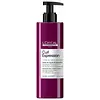What's inside
What's inside
 Benefits
Benefits

 Concerns
Concerns

 Ingredients Side-by-side
Ingredients Side-by-side

Water
Skin ConditioningCetearyl Alcohol
EmollientGlycol Stearate
EmollientCetyl Alcohol
EmollientParfum
MaskingDimethicone
EmollientBehentrimonium Methosulfate
Ceteareth-20
CleansingArgania Spinosa Kernel Oil
EmollientHydrolyzed Vegetable Protein Pg-Propyl Silanetriol
Skin ConditioningPPG-1 Trideceth-6
Skin ConditioningPolyquaternium-11
Polyquaternium-37
Polyquaternium-72
Propylene Glycol Dicaprylate/Dicaprate
EmollientButylene Glycol
HumectantCaprylyl Glycol
EmollientC10-40 Isoalkylamidopropylethyldimonium Ethosulfate
Disodium EDTA
Sodium Chloride
MaskingPotassium Sorbate
PreservativeChlorphenesin
AntimicrobialPhenoxyethanol
PreservativeEugenol
PerfumingAlpha-Isomethyl Ionone
PerfumingButylphenyl Methylpropional
PerfumingLinalool
PerfumingHydroxyisohexyl 3-Cyclohexene Carboxaldehyde
MaskingWater, Cetearyl Alcohol, Glycol Stearate, Cetyl Alcohol, Parfum, Dimethicone, Behentrimonium Methosulfate, Ceteareth-20, Argania Spinosa Kernel Oil, Hydrolyzed Vegetable Protein Pg-Propyl Silanetriol, PPG-1 Trideceth-6, Polyquaternium-11, Polyquaternium-37, Polyquaternium-72, Propylene Glycol Dicaprylate/Dicaprate, Butylene Glycol, Caprylyl Glycol, C10-40 Isoalkylamidopropylethyldimonium Ethosulfate, Disodium EDTA, Sodium Chloride, Potassium Sorbate, Chlorphenesin, Phenoxyethanol, Eugenol, Alpha-Isomethyl Ionone, Butylphenyl Methylpropional, Linalool, Hydroxyisohexyl 3-Cyclohexene Carboxaldehyde
Water
Skin ConditioningCetearyl Alcohol
EmollientGlycerin
HumectantIsopropyl Myristate
EmollientHydroxypropyl Guar
Emulsion StabilisingBis-Diglyceryl Polyacyladipate-2
EmollientCetearyl Glucoside
EmulsifyingSodium Benzoate
MaskingCocos Nucifera Oil
MaskingCaprylyl Glycol
EmollientButyrospermum Parkii Butter
Skin ConditioningSclerotium Gum
Emulsion StabilisingCitric Acid
BufferingHydroxyethyl Urea
HumectantLimonene
PerfumingBenzyl Salicylate
PerfumingBenzyl Alcohol
PerfumingHibiscus Esculentus Seed Extract
Skin ConditioningPhenoxyethanol
PreservativeParfum
MaskingWater, Cetearyl Alcohol, Glycerin, Isopropyl Myristate, Hydroxypropyl Guar, Bis-Diglyceryl Polyacyladipate-2, Cetearyl Glucoside, Sodium Benzoate, Cocos Nucifera Oil, Caprylyl Glycol, Butyrospermum Parkii Butter, Sclerotium Gum, Citric Acid, Hydroxyethyl Urea, Limonene, Benzyl Salicylate, Benzyl Alcohol, Hibiscus Esculentus Seed Extract, Phenoxyethanol, Parfum
Ingredients Explained
These ingredients are found in both products.
Ingredients higher up in an ingredient list are typically present in a larger amount.
Caprylyl Glycol is a humectant and emollient, meaning it attracts and preserves moisture.
It is a common ingredient in many products, especially those designed to hydrate skin. The primary benefits are retaining moisture, skin softening, and promoting a healthy skin barrier.
Though Caprylyl Glycol is an alcohol derived from fatty acids, it is not the kind that can dry out skin.
This ingredient is also used as a preservative to extend the life of products. It has slight antimicrobial properties.
Learn more about Caprylyl GlycolCetearyl alcohol is a mixture of two fatty alcohols: cetyl alcohol and stearyl alcohol. It is mainly used as an emulsifier. Emulsifiers help prevent the separation of oils and products. Due to its composition, it can also be used to thicken a product or help create foam.
Cetearyl alcohol is an emollient. Emollients help soothe and hydrate the skin by trapping moisture.
Studies show Cetearyl alcohol is non-toxic and non-irritating. The FDA allows products labeled "alcohol-free" to have fatty alcohols.
This ingredient is usually derived from plant oils such as palm, vegetable, or coconut oils. There is debate on whether this ingredient will cause acne.
Due to the fatty acid base, this ingredient may not be Malassezia folliculitis safe.
Learn more about Cetearyl AlcoholParfum is a catch-all term for an ingredient or more that is used to give a scent to products.
Also called "fragrance", this ingredient can be a blend of hundreds of chemicals or plant oils. This means every product with "fragrance" or "parfum" in the ingredients list is a different mixture.
For instance, Habanolide is a proprietary trade name for a specific aroma chemical. When used as a fragrance ingredient in cosmetics, most aroma chemicals fall under the broad labeling category of “FRAGRANCE” or “PARFUM” according to EU and US regulations.
The term 'parfum' or 'fragrance' is not regulated in many countries. In many cases, it is up to the brand to define this term.
For instance, many brands choose to label themselves as "fragrance-free" because they are not using synthetic fragrances. However, their products may still contain ingredients such as essential oils that are considered a fragrance by INCI standards.
One example is Calendula flower extract. Calendula is an essential oil that still imparts a scent or 'fragrance'.
Depending on the blend, the ingredients in the mixture can cause allergies and sensitivities on the skin. Some ingredients that are known EU allergens include linalool and citronellol.
Parfum can also be used to mask or cover an unpleasant scent.
The bottom line is: not all fragrances/parfum/ingredients are created equally. If you are worried about fragrances, we recommend taking a closer look at an ingredient. And of course, we always recommend speaking with a professional.
Learn more about ParfumPhenoxyethanol is a preservative that has germicide, antimicrobial, and aromatic properties. Studies show that phenoxyethanol can prevent microbial growth. By itself, it has a scent that is similar to that of a rose.
It's often used in formulations along with Caprylyl Glycol to preserve the shelf life of products.
Water. It's the most common cosmetic ingredient of all. You'll usually see it at the top of ingredient lists, meaning that it makes up the largest part of the product.
So why is it so popular? Water most often acts as a solvent - this means that it helps dissolve other ingredients into the formulation.
You'll also recognize water as that liquid we all need to stay alive. If you see this, drink a glass of water. Stay hydrated!
Learn more about Water